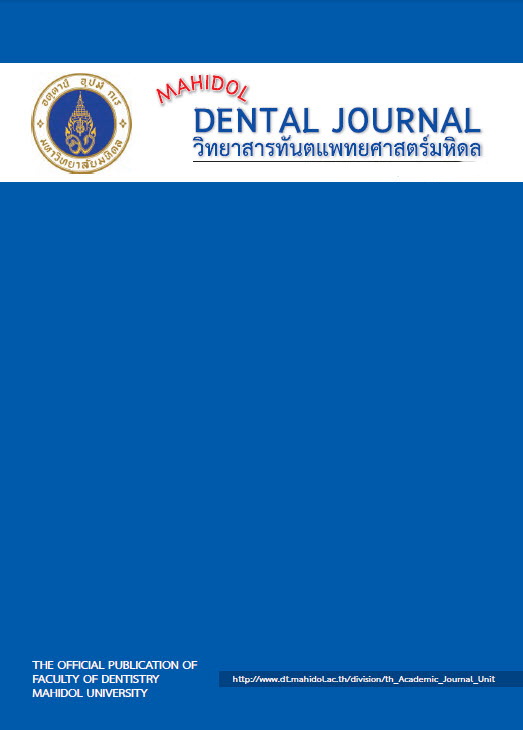Closing Spaces With Partial Ceramic Veneers: A Clinical Report
Main Article Content
Abstract
This clinical report describes optionally conservative concepts in closing spaces in anterior teeth, consisting of non-preparation partial ceramic veneers and composite resins. A 32-year-old Thai female with the chief complaint of having spaces between her anterior teeth. The intra-oral examination found spaces between 12 and 13, 22 and 23, 42 and 43. Moreover the patient presented unpleasant previous diastema closure with composite resin in terms of a shifted and canted dental midline. The repeated proportion was used to calculate the width of each upper anterior tooth for planning. This clinical report included partial ceramic veneers in the treatment plan as an option to close spaces which would be considered as non-invasive technique. In this clinical report, partial ceramic veneers achieved not only good esthetic results but also showed the strength and predictable longevity of restorations on bonded enamel.
Article Details
References
2. D'Arcangelo C, Vadini M, D'Amario M, Chiavaroli Z, De Angelis F. Protocol for a new concept of no-prep ultrathin ceramic veneers. J Esthet Restor Dent. 2017.
3. Gillen RJ, Schwartz RS, Hilton TJ, Evans DB. An analysis of selected normative tooth proportions. Int J Prosthodont. 1994; 7(5): 410-7.
4. Sawai MA, Bhardwaj A, Jafri Z, Sultan N, Daing A. Tooth polishing: The current status. J Indian Soc Periodontol. 2015; 19: 375-80.
5. Meola MT, Papaccio G, Caporaso S, Tolino A. Morphology of the aprismatic enamel: a SEM study of different etching. Boll Soc Ital Biol Sper. 1984; 60: 2325-31.
6. Lopes GC, Thys DG, Klaus P, Oliveira GM, Widmer N. Enamel acid etching: a review. Compend Contin Educ Dent. 2007; 28: 18-24.
7. Papacchini F, Monticelli F, Hasa I, Radovic I, Fabianelli A, Polimeni A, et al. Effect of air-drying temperature on the effectiveness of silane primers and coupling blends in the repair of a microhybrid resin composite. J Adhes Dent. 2007; 9: 391-7.
8. Materdomini D, Friedman MJ. The contact lens effect: enhancing porcelain veneer esthetics. J Esthet Dent. 1995; 7: 99-103.
9. Fons-Font A, Sola-Ruiz MF, Granell-Ruiz M, Labaig-Rueda C, Martinez-Gonzalez A. Choice of ceramic for use in treatments with porcelain laminate veneers. Med Oral Patol Oral Cir Bucal. 2006; 11: E297-302.
10. Van Meerbeek B. Dentin/enamel bonding. J Esthet Restor Dent. 2010; 22: 157.
11. De Munck J, Van Landuyt K, Peumans M, Poitevin A, Lambrechts P, Braem M, et al. A critical review of the durability of adhesion to tooth tissue: methods and results. J Dent Res. 2005; 84:118-32.
12. Pahlevan A, Mirzaee M, Yassine E, Ranjbar Omrany L, Hasani Tabatabaee M, Kermanshah H, et al. Enamel thickness after preparation of tooth for porcelain laminate. J Dent (Tehran). 2014; 11: 428-32.
13. Ban S. Reliability and properties of core materials for all-ceramic dental restorations.
Jpn Dent Sci Rev. 2008; 44: 3-21.
14. Chang J, Da Silva JD, Sakai M, Kristiansen J, Ishikawa-Nagai S. The optical effect of composite luting cement on all ceramic crowns. J Dent. 2009; 37: 937-43.
15. Begum Z, Chheda P, Shruthi CS, Sonika R. Effect of Ceramic Thickness and Luting Agent Shade on the Color Masking Ability of Laminate Veneers. J Indian Prosthodont Soc. 2014; 14: 46-50.
16. Volpato CÂM, Monteiro S, Jr., de Andrada MC, Fredel MC, Petter CO. Optical influence of the type of illuminant, substrates and thickness of ceramic materials. Dent Mater.25: 87-93.
17. Jankar AS, Kale Y, Pustake S, Bijjaragi S, Pustake B. Spectrophotometric Study of the Effect of Luting Agents on the Resultant Shade of Ceramic Veneers: An Invitro Study. J Clin Diagn Res. 2015; 9: 56-60.
18. Paul SJ, Peter A, Rodoni L, Pietrobon N. Conventional visual vs spectrophotometric shade taking for porcelain-fused-to-metal crowns: A clinical comparison. J Prosthet Dent. 2004; 92: 577.
19. Nicolaisen MH, Bahrami G, Schropp L, Isidor F. Functional and Esthetic Comparison of Metal-Ceramic and All-Ceramic Posterior Three-Unit Fixed Dental Prostheses. Int J Prosthodont. 2016; 29: 473-81.


